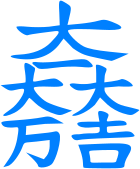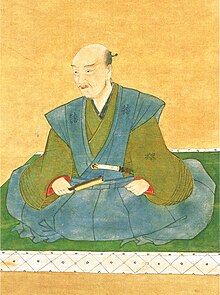Ishida Mitsunari

Ishida Mitsunari ( Japanese 石田 三 成 , also Ishida Kazushige ; * 1560 in Ōmi ; † November 6, 1600 (traditional: Keichō 5/10/1) in Kyōto ) was a samurai and military leader who defeated the alliance of the in the Battle of Sekigahara later Shogun Tokugawa Ieyasu was defeated.
Life
Ishida was born the son of Ishida Masatsugu in the province of Omi in 1560.
After the destruction of the Azai clan in 1573, which his family had served, he entered the service of Toyotomi Hideyoshi , in whose campaigns he took part. After the successful takeover of power by his master in 1582 he rose to one of Toyotomi's most influential vassals, whose friendship he won and received a fiefdom as daimyo from Sawayama in his home province, which secured him a high income with 500,000 koku .
Ishida was responsible for the finances of Toyotomi's government team, and later he and his older brother Ishida Masazumi took over Osaka . With a bureaucratic disposition, he was also known for his stubbornness, which brought him into conflict with some daimyos even in Toyotomi's time. In 1597, during the second Imjin campaign, he was appointed inspector of the troops and his behavior incited the hatred of Kuroda Yoshitaka and Kobayakawa Hideaki.
After Toyotomi's death in 1598, the conflict over the succession flared up, because Toyotomi left only one small son, Toyotomi Hideyori , who was his father's nominal successor. The Council of Five Regents , of which Ishida was also a member, as well as Tokugawa Ieyasu, could not prevent the conflict. He legitimately accused the Tokugawa clan of not caring about Toyotomi's heir and last will, but only about increasing their own power. 1599 tried Ishida Tokugawa Ieyasu to be murdered, but failed and narrowly escaped the Tokugawa clan. He also took parts of the Tokugawa clan, most of them women, as hostages at Osaka Castle, which, however, did not give him any advantage in the power struggle.
Ishida managed to get several great daimyos to join his coalition against Tokugawa Ieyasu and then tried to bring about a decision on the war route. In the run-up to the Battle of Sekigahara, Ishida Torii besieged Mototada with the garrison of Fushimi Castle by his vastly superior army. The garrison held out for over 10 days before falling. This gave Ieyasu the opportunity to raise a powerful army. However, the garrison was completely wiped out and Mototada committed seppuku .
The final decision was made at the Battle of Sekigahara on October 21, 1600, in which Ishida was defeated as de facto commander of the western army of the Toyotomi camp by the eastern army of the Tokugawa camp. Tokugawa's victory was achieved through the betrayal of Kobayakawa Hideaki , who entered the battle late with his 8,000 warriors, but not on the side of Ishida, as was actually planned. In the subsequent course of the battle, more faithless daimyos went over to Tokugawa Ieyasu.
Ishida Mitsunari was captured on the subsequent escape after the lost battle and beheaded in Kyoto , his father and older brother committed Seppuku beforehand . His head was on public display as a deterrent, but it was rumored that it soon disappeared mysteriously.
His remains were buried in the Okunoin (奥 の 院) cemetery in Kōya-san in the mountains south of Osaka, the largest and most important cemetery in Japan.
He and his wife had 3 sons (Shigeie, Shigenari and Sakichi) and three daughters (only the name of the youngest daughter is known, Tatsuko), as well as another child with his mistress .
Shogun
In the novel Shogun by James Clavell Ishida is as Ishido shown. The Japanese actor Nobuo Kaneko plays the role of Ishidos in the television series Shogun with Richard Chamberlain in the leading role, which was filmed based on the novel. In the film The Legend of Goemon (2009) by Kazuaki Kiriya, Ishida Mitsunari is one of the villains and is played by the then 28-year-old Jun Kaname .
Individual evidence
- ↑ a b c d samurai-archives.com: Ishida Mitsunari , accessed April 3, 2011
- ↑ a b c trentu.ca: Ishida Mitsunari ( Memento of the original from May 29, 2015 in the Internet Archive ) Info: The archive link was inserted automatically and has not yet been checked. Please check the original and archive link according to the instructions and then remove this notice. , Accessed April 3, 2011
Web links
| personal data | |
|---|---|
| SURNAME | Ishida, Mitsunari |
| ALTERNATIVE NAMES | 石田 三 成 (Japanese) |
| BRIEF DESCRIPTION | Japanese military leader and daimyo |
| DATE OF BIRTH | 1560 |
| PLACE OF BIRTH | Ōmi |
| DATE OF DEATH | November 6, 1600 |
| Place of death | Kyoto |



